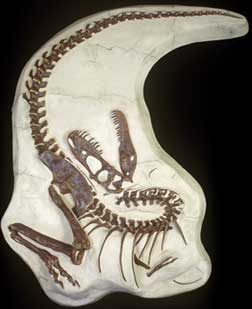|
News Notes
Paleontology
Large dinosaurs ran hot
 Size does matter — at least when it comes to dinosaurs’ body temperatures, according to new research. Using growth rate and age information gleaned from fossils, researchers have estimated likely body temperatures for dinosaurs of various sizes, as well as tyrannosaur survival rates.
Size does matter — at least when it comes to dinosaurs’ body temperatures, according to new research. Using growth rate and age information gleaned from fossils, researchers have estimated likely body temperatures for dinosaurs of various sizes, as well as tyrannosaur survival rates.
New fossil evidence indicates that fossilized remains of juvenile tyrannosaurs, like the one shown here, are rare because mortality was low for tyrannosaurs until they reached sexual maturity. Such fossil evidence is also helping researchers better understand other dinosaur trends, such as internal temperatures. Image is courtesy of Ed Gerken and copyright 1995 BHIGR.
Exactly how dinosaurs regulated their temperatures has long been debated. Some scientists think dinosaurs regulated their body heat internally, similar to modern warm-blooded birds and mammals. Others think that dinosaur temperatures changed based on the local environment, similar to modern cold-blooded reptiles. Still other researchers think that the temperature mechanism was related to the animal’s size: Small dinosaurs depended on environmental heat, but large dinosaurs had body masses that made it difficult for them to cool down and meant they had higher, more constant temperatures — a circumstance scientists call “inertial homeo-thermy.” The effect is similar to large bodies of water, which are difficult to heat or cool significantly.
If inertial homeothermy applied to dinosaurs, then large dinosaurs should have been significantly hotter than small dinosaurs, wrote James Gillooly, a physiological ecologist at the University of Florida in Gainesville, and colleagues in the August 2006 PLoS Biology. To find out if large dinosaurs were indeed hotter, the team turned to a previously published mathematical equation that estimates an animal’s body temperature, given that growth rate and maximum body size are known.
The team pulled together previously published growth rate data for eight dinosaur species that ranged in mass from 12 to almost 26,000 kilograms. That information was only recently made available due to recent headway in microscopic bone studies, in which researchers have counted layers in the bone, similar to rings on a tree, to estimate growth rate and age.
Next, the team applied the equation to solve for the temperature of each species and plotted the relationship on a graph. The approach “provides the potential” for quantitative predictions about dinosaur lives that can be tested with fossil data, Gillooly says.
Gillooly’s team found that the small 12-kilogram dinosaur Psittacosaurus mongoliensis was a cool 25 degrees Celsius (77 degrees Fahrenheit) — that’s close to the time period’s mean environmental temperature, implying the small dinosaur had a reptilian temperature regulation system that depended on the environment, Gillooly says. The weighty 12,979-kilogram Apatosaurus excelus, however, was a balmy 41 degrees Celsius (106 degrees Fahrenheit), implying that it “had problems dissipating that heat,” Gillooly says, thus supporting the idea that inertial homeothermy affected at least some large dinosaurs.
Extrapolating the trend beyond the existing dinosaur data, the equation suggested that the 55,000-kilogram Sauroposeidon proteles, one of the largest known dinosaurs, would have measured 48 degrees Celsius (118 degrees Fahrenheit). That’s slightly above the temperature at which proteins begin to break down, which may have limited how large dinosaurs could grow, Gillooly says.
The results, however, are not likely to have a large impact on the dinosaur temperature debate, says Peter Makovicky, a paleontologist at The Field Museum in Chicago, Ill. The equation, which the researchers demonstrated applies to modern reptiles, is broadly applicable and should “technically apply” to dinosaurs as well, but “the devil’s in the details,” he says. Large dinosaurs could have had some other mechanism for “dumping heat,” which is difficult to determine from fossils, he says.
Still, the research is exciting because it is part of a recent trend of “looking at dinosaurs as biological systems,” Makovicky says. For example, in a separate study published in the July 14 Science, researchers used the bone analysis technique and a large sample fossil population to put together the first survival history of tyrannosaurs.
Gregory Erickson, a paleobiologist at Florida State University in Tallahassee, and colleagues looked at 22 Albertosaurus sarcophagus individuals, all of which died at the same time, and were discovered in 1910 in Alberta, Canada. Bone analysis revealed the dinosaurs’ ages, which the team used to determine age-specific mortality rates.
Erickson’s team found that A. sarcophagus fared the best between two and 13 years old, when the mortality rate was just 3.5 percent. But mortality rates jumped to almost 23 percent for individuals between 14 and 23 years old — at which point A. sarcophagus reached sexual maturity. Competition for mates, increased stress and predation during that time may have contributed to the increased mortality, the team wrote.
Survival studies can begin to tell researchers more about dinosaur ecosystems, Makovicky says, such as how “robust or fragile” a particular species may have been. So far, a lot of dinosaur biology — temperature regulation mechanisms and mortality rate explanations — is “speculative,” he says, but the data provide better parameters to begin talking about how dinosaurs fit into what Gillooly calls the evolutionary “tree of life.”
Kathryn Hansen
Links:
"Tiny T. rex cousin,"
Geotimes, April 2006

 Subscribe
Subscribe

